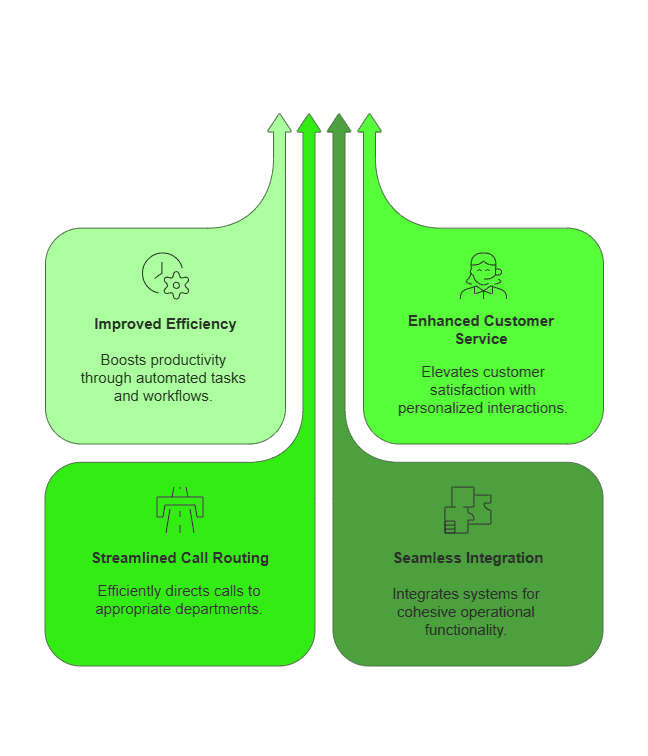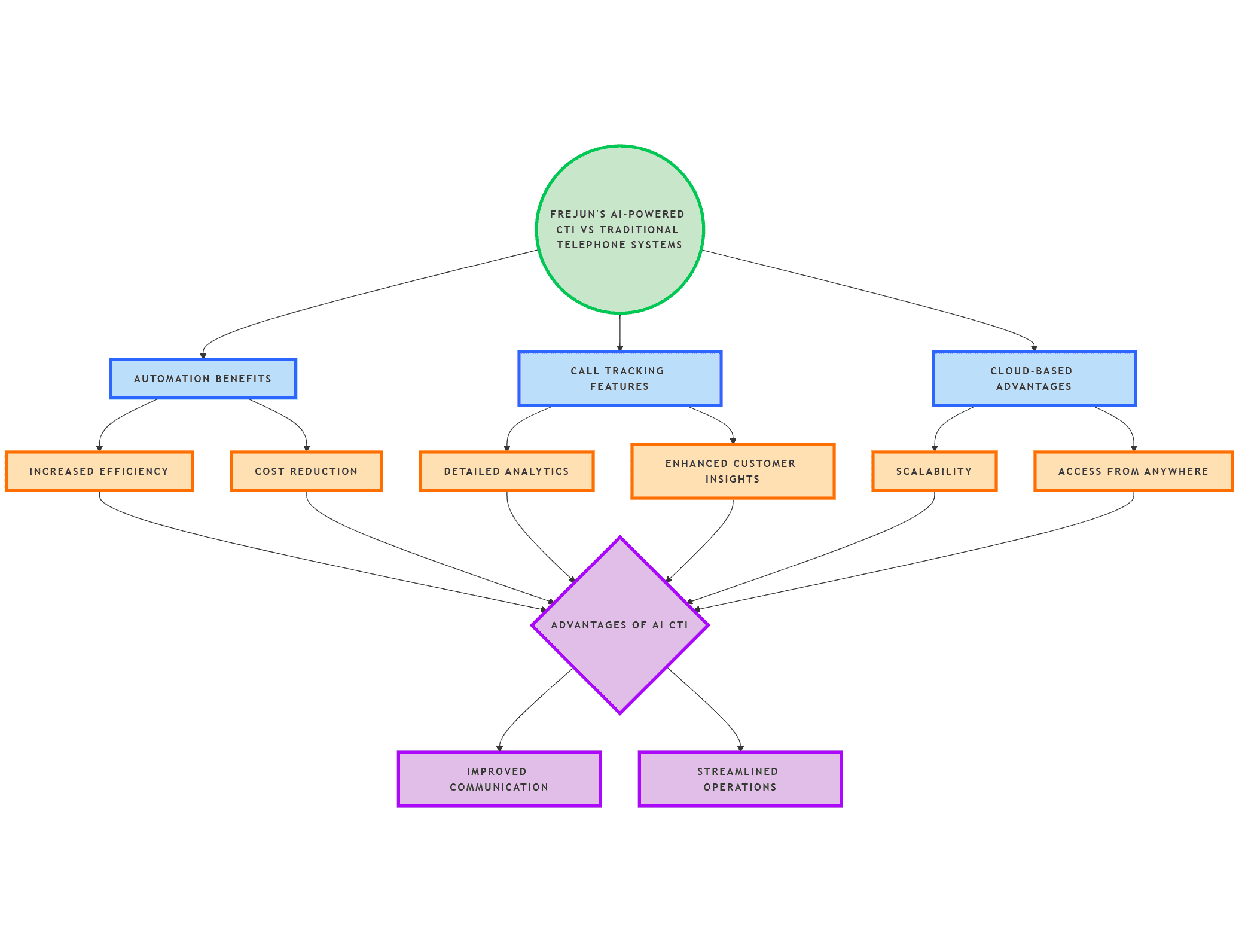Last updated on April 25th, 2025 at 03:40 pm
In today’s interconnected business landscape, integrating computer telephones with other systems can greatly improve communication efficiency and streamline operations. Computer Telephony Integration (CTI) enables the convergence of telephone and computer systems. This allows businesses to leverage various applications and tools to enhance customer service, sales, and overall productivity. In 2025, computer telephony integration (CTI) has become essential for businesses looking to streamline their communication processes. Whether it’s CRM, helpdesk software, ERP, or AI-driven analytics, integrating your VoIP or computer telephony system enhances productivity and customer experience.
In this article, we will explore the fundamentals of CTI and discuss the benefits it offers. We will also provide a step-by-step guide on how to successfully integrate computer telephony with other systems.
Table of contents
- What is Computer Telephony Integration ?
- Benefits of Computer Telephony Integration
- FreJun vs. Traditional CTI Solutions
- Preparing for Integration
- Key Integration Benefits with FreJun
- Choosing the Right Computer Telephony System
- API For Cloud Telephony
- How APIs can be Used and Integrated?
- SDKs for Cloud Telephony
- Iframe Integration for Cloud Telephony
- Conclusion
- Frequently Asked Questions
What is Computer Telephony Integration ?
Computer Telephony Integration (CTI) refers to the technology that enables the integration of computer telephone systems. With CTI, businesses can facilitate seamless communication between voice and data networks. This allows for efficient call routing, call monitoring, and data transfer.
Computer Telephony Integration involves connecting and integrating computer telephone systems with computer applications and databases. By integrating telephony and computer systems, businesses can automate processes, improve call handling, and enhance customer service. CTI enables features such as click-to-dial, automatic call logging, screen-pop, and call routing based on customer data.
Benefits of Computer Telephony Integration

The benefits of integrating computer telephony with other systems are numerous. As enterprises strive to optimize operations and provide exceptional customer service, CTI offers the following advantages:
- Improved Efficiency: CTI automates tasks, reducing manual effort and minimizing errors. It enables call center agents to access customer information instantly, improving response times and overall productivity.
- Enhanced Customer Service: CTI enables personalized customer interactions by providing agents with relevant customer data during calls. This empowers agents to understand customer needs and provide tailored solutions, resulting in higher customer satisfaction.
- Streamlined Call Routing: CTI systems can route incoming calls based on preset rules or customer data. This reduces call transfer times and ensuring calls reach the right agents or departments promptly.
- Seamless Integration: By integrating telephony systems with CRM, help desk, or other business applications, CTI eliminates the need for manual data entry, reduces errors, and streamlines workflows.
CTI enables businesses to implement advanced call-handling features, such as interactive voice response (IVR) systems and automatic call distribution (ACD). IVR systems allow callers to interact with a computerized menu to access information or perform certain actions. This reduces the need for human intervention. ACD systems intelligently distribute incoming calls to the most appropriate agents based on factors like skillset, availability, and customer priority, ensuring efficient call handling and minimizing wait times.
CTI can also integrate with customer relationship management (CRM) systems. This provides a holistic view of customer interactions and enabling seamless data synchronization. This integration allows businesses to track and manage customer interactions across multiple channels, such as phone, email, and chat, providing a unified and consistent customer experience.
Click here to schedule a call to discuss your CTI Integration needs.
FreJun vs. Traditional CTI Solutions

Preparing for Integration
Before proceeding with the integration of computer telephones with other systems, it is crucial to assess your current system and identify the specific integration needs of your business.
Integration of computer telephony (CTI) can revolutionize the way your business communicates and operates. By seamlessly combining telephony and computer systems, you can enhance customer service, streamline operations, and improve overall efficiency. However, a successful integration requires careful planning and consideration of various factors.
Key Integration Benefits with FreJun
| Business Type | Why Choose FreJun? |
| Startups | Scalable and cost-effective VoIP solutions |
| Freelancers | Flexible international call plans |
| Small Businesses | AI-powered automation for call handling |
| Enterprises | Advanced analytics & CRM integration |
Assessing Your Current System
Begin by evaluating your existing telephony infrastructure and computer systems. Identify the telephony equipment, phone lines, and software applications currently in use. Consider factors such as the age of the equipment, compatibility with CTI technology, and overall performance. It is essential to determine if your systems can support CTI or if upgrades or replacements are necessary to ensure smooth integration.
Furthermore, assess the network infrastructure and bandwidth capacity to support the increased data traffic that comes with CTI integration. Conducting a thorough assessment of your current system will provide valuable insights into areas that may require attention or improvement before embarking on the integration process.
Identifying Integration Needs
Consider the objectives and requirements of your integration project. Clearly define the goals you aim to achieve through CTI integration and prioritize the systems and applications that will benefit the most from this integration. Whether you intend to enhance customer relationship management, optimize help desk operations, or improve internal communication, identifying your integration needs is crucial for a successful implementation.
Collaborate with key stakeholders across different departments to gather insights and feedback on the integration requirements. By involving relevant teams in the decision-making process, you can ensure that the integration aligns with the overall business objectives and meets the specific needs of each department. Additionally, consider future scalability and flexibility in your integration strategy to accommodate potential growth and evolving business requirements.
Choosing the Right Computer Telephony System
Choosing the right computer telephony system is crucial to the success of your integration project. A well-selected CTI system can streamline communication processes, enhance customer service, and boost overall productivity. Whether you are a small business or a large enterprise, finding the perfect fit for your organization is paramount.
Consider the following key features and factors when selecting a CTI system:
Key Features to Look For

Look for a CTI system that offers features such as:
- Screen Pop: The ability to automatically display customer information on agent screens when a call is received.
- Click-to-Dial: The ability to initiate calls by clicking on phone numbers within computer applications.
- Call Logging: Automatic logging of call details, including call duration, caller ID, and call outcome.
- Call Routing: The option to route calls based on customer data, time of day, or other predefined rules.
These features can significantly improve operational efficiency, reduce call handling times, and provide a more personalized experience for customers.
Evaluating Different Providers
Research and compare different CTI providers to find the one that best meets your integration needs. Consider factors such as pricing, compatibility, scalability, and customer support. Request demos or trials to assess the usability and functionality of the CTI systems under consideration.
Furthermore, delve into the reputation of the providers by seeking out reviews and testimonials from other businesses that have implemented their systems. A reliable CTI provider should offer not only a robust product but also excellent ongoing support to ensure smooth implementation and operation.
API For Cloud Telephony
Application Programming Interfaces (APIs) for Cloud Telephony refers to a set of programmatic interfaces that allow developers to manage and integrate voice call functionalities into cloud-based applications. These APIs, such as those provided by the Telephony Integration REST API, enable operations like creating, updating, and transcribing voice call records, routing calls through omni-channel flows, and managing real-time and post-call conversation events.
Authorization for these APIs typically involves JWT tokens, ensuring secure access and interaction with telephony systems. By utilizing these APIs, businesses can streamline call management processes, enhance operational efficiency, and seamlessly integrate computer telephone services with other cloud-based applications and services.
Click here to schedule a call to discuss your CTI API needs.
How APIs can be Used and Integrated?
APIs can be used and integrated to enable seamless communication and data exchange between different software systems, enhancing overall functionality and efficiency. The integration process involves connecting APIs to allow diverse systems to sync information, leverage features across applications, and incorporate external services. Various types of APIs can be integrated based on specific needs, including REST APIs for lightweight and flexible data transfer, SOAP APIs for structured and secure enterprise-level integration, and GraphQL APIs for precise data queries.
Internal APIs facilitate connectivity within an organization, while Open APIs enable public access for third-party development. Successful API integration involves careful planning, selecting appropriate authentication methods, ensuring accurate data transfer and synchronization, and implementing robust error handling and troubleshooting processes. Benefits of API integration include improved efficiency, enhanced user experience, increased revenue, and automation of processes, all contributing to streamlined operations and a competitive edge in digital transformation.
SDKs for Cloud Telephony
Software Development Kits (SDKs) and APIs are essential for web communication and integrating third-party services. Voice and video call SDKs and in-app messaging simplify the complexities of building real-time communication features, saving businesses time and resources. These tools provide tested, adaptable APIs that connect millions of users in real-time, allowing businesses to expand their reach effortlessly.
The primary requirement is a functional SDK tool that integrates seamlessly into existing applications, enhancing communication capabilities.
Click here to schedule a call to discuss your CTI SDKs requirements.
Iframe Integration for Cloud Telephony
Iframe integration for cloud telephony allows businesses to embed communication features such as voice and video calls, messaging, and more directly into their web applications. This approach simplifies the implementation process, enabling quick deployment without extensive development work. By leveraging iframes, companies can provide seamless communication experiences within their existing interfaces, enhancing user engagement and satisfaction.
The integration process involves embedding a secure iframe that connects to a cloud telephony provider’s services, ensuring reliable and scalable communication capabilities without complex infrastructure.
Click here to schedule a call to discuss your CTI Iframe requirements.
Conclusion
Integrating computer telephones with other systems through Computer Telephony Integration (CTI) offers significant benefits, including improved efficiency, enhanced customer service, and streamlined operations. By enabling seamless communication between telephony and computer systems, CTI allows businesses to automate processes, provide personalized customer interactions, and optimize call handling.
Preparing for integration involves assessing current systems, identifying specific needs, and selecting the right CTI solution with essential features such as screen pop, click-to-dial, call logging, and routing. Additionally, leveraging APIs for cloud telephony can enhance integration by enabling real-time call management and data synchronization with cloud-based applications.
With computer telephony integration (CTI) evolving rapidly in 2025, businesses need a reliable and efficient VoIP provider to stay ahead. FreJun offers the best integration features, ensuring seamless CRM connectivity, AI automation, and superior call tracking.
🌍 Upgrade to FreJun today and experience the future of VoIP integration! 🚀
Further Reading: 13 Essential Apps for International Calls
Frequently Asked Questions
It refers to connecting telephone systems with computer applications, such as CRM or helpdesk tools. FreJun offers seamless integration to streamline calls and workflows.
Common integrations include CRMs, ticketing systems, ERPs, and email platforms. FreJun connects easily with all major systems to improve data accessibility and productivity.
Most platforms provide no-code or low-code options for integration. FreJun offers API-based and plug-in integrations that are easy to implement.
Yes, by displaying caller info and history instantly. FreJun helps support teams respond faster and more personally with contextual data.
It boosts efficiency by logging calls, tracking interactions, and automating follow-ups. FreJun enhances CRM capabilities through real-time telephony syncing.
It allows quick dialing, call logging, and pipeline tracking. FreJun empowers sales teams with one-click calling and auto-logging features.
Yes, most modern systems work well with cloud services. FreJun is fully cloud-based and integrates smoothly with SaaS tools.
Subhash is the Founder of FreJun, the global call automation platform. With 8+ years of entrepreneurial experience, FreJun was established to help customers with their voice communication needs. The goal of FreJun is to develop cutting edge technology and solutions to help customers.
